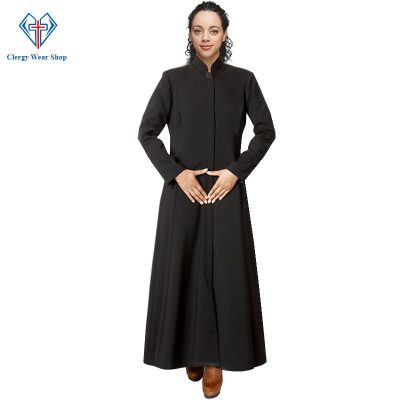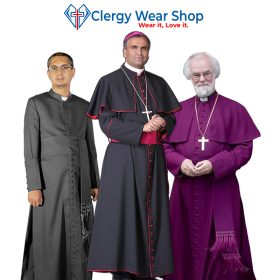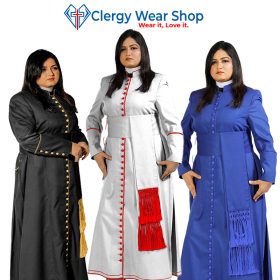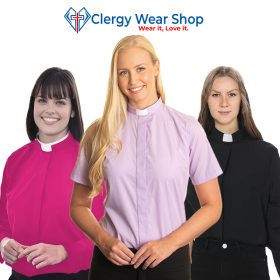Clergy Robes for Men, Clergy Robes for Women
Classic Cassock for Priests
Disclosing the Secrets of Clerical Garments
What clothes do priest wear? Priests typically wear clerical attire consisting of a black cassock, a full-length garment with a close-fitting waist, and a white clerical collar. This attire symbolizes their religious vocation and often reflects modesty and reverence. Additionally, priests may wear a surplice, a loose white outer garment worn over the cassock during liturgical ceremonies. Some religious orders or occasions may call for variations in attire, but the cassock and clerical collar remain distinctive elements of a priest’s clothing.
Introduction
Priest wear holds profound significance in religious ceremonies, embodying tradition, reverence, and symbolism. From elaborate robes to ceremonial accessories, priestly attire reflects centuries of cultural heritage and spiritual devotion. The intricate world of priest wear, unraveling its historical roots, symbolic meanings, and contemporary adaptations.
Exploring Traditional Garments
The Vestments of the Clergy
In the solemn rituals of religious worship, priest wear plays a pivotal role, distinguishing clergy members and accentuating the sacredness of their duties. Traditional garments such as chasubles, albs, and stoles symbolize the priest’s role as a mediator between the divine and the congregation. These vestments, adorned with intricate embroidery and symbolic motifs, convey spiritual authority and solemnity.
Cassock | The Emblem of Clerical Authority
The cassock, a traditional garment worn by clergy members, is steeped in religious and cultural significance. This ankle-length robe, often black, symbolizes humility and devotion in various Christian denominations. Its origins trace back centuries, evolving from ancient tunics worn by early Christians. The cassock’s design typically includes a close-fitting bodice with long, flowing sleeves. It serves not only as a symbol of religious authority but also practicality, offering warmth and protection during religious ceremonies. Beyond its functional role, the cassock embodies a sense of spiritual identity and commitment, representing the solemn vows and dedication of those who wear it in service to their faith.

Surplices and Rochets | Symbols of Purity and Holiness
Surplices and rochets are distinctive garments worn by clergy members during religious ceremonies. The surplice is a loose, white outer garment with wide sleeves, often worn over a cassock. It symbolizes purity and is commonly worn by priests, deacons, and acolytes in various Christian denominations. Rochets, on the other hand, are similar to surplices but are typically shorter and more fitted. They often feature lace or other decorative elements and are worn by bishops, cardinals, and sometimes other high-ranking clergy members. Both surplices and rochets serve as symbols of the clerical office and are integral parts of liturgical vestments worn during worship services.
Symbolism in Priest Wear
In the vibrant tapestry of priestly vestments, colors hold profound symbolic significance. White symbolizes purity and innocence, while red signifies sacrifice and martyrdom. Green represents hope and renewal, purple denotes penitence and royalty, and black conveys solemnity and mourning.
The intricate embroidery adorning priestly vestments abounds with symbolic motifs drawn from religious iconography. Crosses, Chi-Rho symbols, and biblical scenes embellish chasubles and stoles, enriching the visual language of worship with layers of meaning and tradition.
Modern Adaptations and Contemporary Trends
In contemporary religious practice, priest wear has undergone subtle transformations to accommodate evolving sensibilities and aesthetic preferences. Modern clergy members may opt for tailored suits or simplified vestments, blending traditional solemnity with contemporary elegance.
Ecumenical Influences and Cross-Cultural Exchange
Globalization and interfaith dialogue have facilitated cross-cultural exchanges in priestly attire, enriching traditional styles with diverse influences and interpretations. From African-inspired patterns to Asian motifs, priest wear reflects the rich tapestry of global religious diversity. What clothes do priest wear?
Addressing Common Questions About Priest Wear
What is the significance of the cassock in Catholicism?
In Catholicism, the cassock holds significant symbolism and practical importance. It serves as a symbol of the clergy’s dedication, humility, and service to God and the Church. The black color of the cassock signifies renunciation of worldly desires and adherence to a life of simplicity and piety.
Additionally, the cassock is a reminder of the clerical vows of poverty, chastity, and obedience taken by priests and other members of the clergy. By wearing the cassock, Catholic clergy publicly demonstrate their commitment to these vows and their readiness to serve God and the faithful.

Practically, the cassock provides a sense of uniformity among clergy members and distinguishes them from the laity during religious ceremonies. It also offers warmth and protection during colder weather and serves as a convenient garment for the attachment of liturgical vestments, such as stoles and chasubles, worn during Mass and other liturgical functions. Overall, the cassock plays a central role in the identity and ministry of Catholic clergy, reflecting their spiritual calling and commitment to serving God and the Church.
How do priestly vestments vary across different religious traditions?
Priestly vestments vary significantly across religious traditions, reflecting diverse theological beliefs and cultural practices. For example, while Catholic clergy often wear cassocks, surplices, and chasubles, Orthodox priests may don phelonia and epitrachelions, showcasing the rich tapestry of religious attire.
Can laypeople wear priestly vestments for special occasions?
Typically, laypeople do not wear priestly vestments for special occasions. These garments hold specific significance within religious contexts and are reserved for ordained clergy during liturgical services. Laypersons may wear ceremonial attire appropriate to their roles, but priestly vestments are generally exclusive to ordained ministers.
Conclusion
In conclusion, priest wear encapsulates the essence of religious tradition, embodying the sacred rituals and spiritual aspirations of clergy members worldwide. From the solemn elegance of traditional vestments to the innovative adaptations of modern attire, priestly garb continues to inspire reverence and awe. By delving into its rich symbolism and historical significance, we gain a deeper appreciation for the enduring legacy of priest wear in religious worship. What clothes do priest wear?

 Clergy Robes for Men
Clergy Robes for Men Clergy Robes for Women
Clergy Robes for Women Clergy Shirts for Men
Clergy Shirts for Men Clergy Shirts for Women
Clergy Shirts for Women